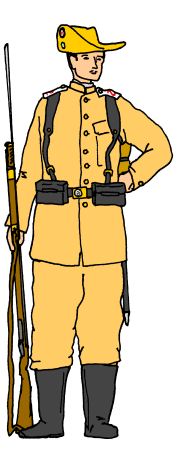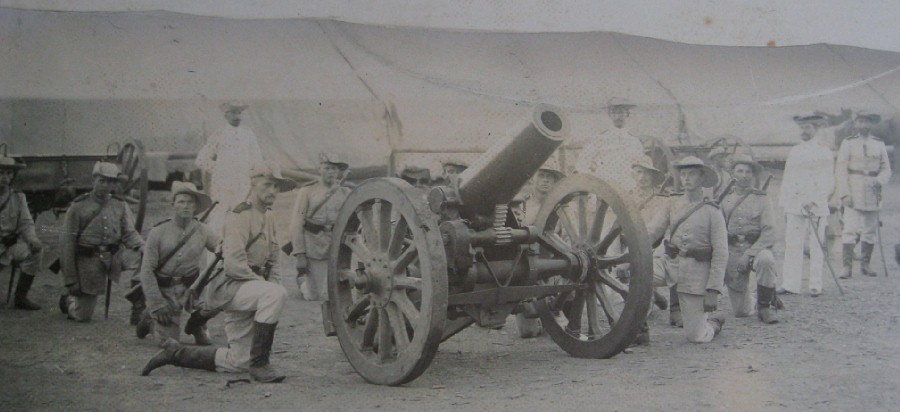Summer Uniforms of the East Asian
Expeditionary Corps
Several variations on the cut of the
Drillichrock tunic can be seen in period photographs. Some tunics had
eight buttons instead of six, some had a single button on each cuff, some
had two breast pockets while others had none. Matching trousers were worn with the tunic, although khaki riding breeches do not seem to have been issued so mounted troops usually wore the dark blue riding breeches from their Winter uniform. On other occasions photographs show troops wearing their khaki trousers with blue Winter uniform tunics. Officers Uniform The commander of the East Asian Expeditionary Corps, Field Marshall Graf von Waldersee and his bodyguard wore the Uniforms of the Imperial Staff in Palestine 1898. Headdress Officers straw hats had a yellow metallic lace band around the base of the hat, while general officers wore larger (4cm wide) band of gold lace. Officers cockades were also more elaborate (again see Cockade Details Page). One photo (on the Boxer Aufstand website) shows a member of the East Asian Expeditionary Corps wearing a large number 4 in dark cloth on the front of his straw hat, presumably a regimental or company number. I have not seen unit numbers in any other period photographs. The straw hat proved to be impractical and unpopular on campaign and on 12th August 1900 was officially replaced by the peaked field cap. The replacement was a gradual one and photographs show it still in use much later than this, some alongside the 1900 Khaki uniform introduced in February 1901. Peaked Cap- The khaki peaked cap ("Bordmutze") was introduced to replace the straw from 12th August 1900 onwards. Troops going to China from this date onwards (including the 5th and 6th Infantry Regiments, the Jäger Company, one cavalry squadron, two field artillery batteries and one heavy artillery battery) were issued the peaked cap in place of the straw hat and troops already in China gradually received the replacement cap from there on. It was a plain khaki cap with a khaki hatband with no piping, the same as worn by the III. Seebatallion. It had an internal wire retaining loop to hold the shape of the crown although the wire loop was often removed. Its peak was made of grey leather. One variation of the cap had a much larger peak, often causing the hat to be worn tilted towards the back of the head. It had a brown leather chinstrap attached on either side with a small brass button. A removable khaki neckshade was issued that attached to these two buttons. A small imperial cockade above a small state cockade was worn on the front of the cap (again see Cockade Details Page). Tropical Helmet- the Bortfeldt Tropical Helmet (see Tropical Helmets Details Page) began to be introduced in advance of the new 1900 Summer uniforms (see East Asian Occupation Brigade Page). Some photographs show some infantrymen wearing the new khaki tropical helmet (with white hatband, imperial cockade on the right hand side and brass imperial eagle on the front) with the old Drillichrock, indicating that the tropical helmet was probably introduced a short time before the rest of the uniform. Footwear The Illustrations He also wears a marksman's award in the form of a lanyard of twisted black/white/red braid across his right breast (see Specialist Insignia Page). As the East Asian Expeditionary Corps was an elite unit formed from the best volunteers from the whole German army, the incidence of marksman's awards was disproportionately high. Equipment and boots are made of blackened leather as was standard in the German army of 1900. Figure 2 is based on a photograph of an Infantryman from the 1st (Saxon) Battalion of the 2nd East Asian Infantry Regiment. He wears a similar straw hat and khaki uniform to that of the pervious figure. The only differences being that he wears a Saxon cockade (white/green/white) below the imperial one on his straw hat and that his tunic unusually has eight buttons down the front and a button on each cuff. Figure 3 is based on a photograph of an Infantryman of the East Asian Expeditionary Corps in full marching order. He wears the same khaki uniform and straw hat as the previous two figures. Although the colour cannot be made out in the original photograph upon which this illustration is based, I have illustrated him with a white cord around the base of his hat for the 1st company from each infantry battalion. Equipment carried by the East Asian Infantry Regiments was the same black leather version as that carried by the regular imperial army of the time. He caries a hide covered back pack, with a tent quarter wrapped around its outside edge and canteen fixed to the back. The bread bag and water bottle are on the right hip while the empty bayonet scabbard is on the left hip. Figure 4 is based on a photograph of an NCO Trumpeter of the East Asian Artillery Regiment. He wears the peaked khaki field cap with removable neckshade issued to the East Asian Expeditionary Corps from August 1900 onwards. Only the East Asian Infantry wore the insignia of their home states, the cavalry, artillery and other arms of service all wore Prussian insignia irrespective of their home units. This NCO has an imperial cockade above a Prussian cockade on the field cap. This NCO also wears the East Asian Expeditionary Corps khaki tunic with NCOs lace around the top and front edges of the standing collar, showing him to be an "Unteroffizier". The shoulder straps are red with a yellow flaming grenade for the artillery. He wears musicians' "swallows nests" in red and yellow on his shoulders and being a mounted bugler, the stripes on his swallows nests are sloped (see Specialist Insignia Page) His bugle is carried and wrapped with cords in state colours (black/silver for Prussia). He wears the dark blue/black riding breeches of his winter uniform. Figure 5 is based on a photograph of an Officer of a Bavarian Infantry Company of the East Asian Expeditionary Corps. He wears the officers Drillichrock with four pockets, and the shoulder straps of a Leutnant in white metallic cord with threads of pale blue for Bavaria. His straw hat has an officers yellow metallic lace band around the hatband and a Bavarian cockade (white/blue/white) below the larger Imperial one. Around his neck he wears a dark coloured (possibly dark blue based on photos of surviving examples) neck stock ("Halsbinde"). This was a small removable collar worn by many officers in the field. He wears matching khaki trousers and privately tailored black riding boots. His belt is that of a Bavarian army officer, similar to the Prussian one but with pale blue stripes and a buckle bearing the Bavarian Lion. On his belt is a binocular case and a pistol holster. He carries a sword with its knot also in the Bavarian colours.
Main Sources-
|







